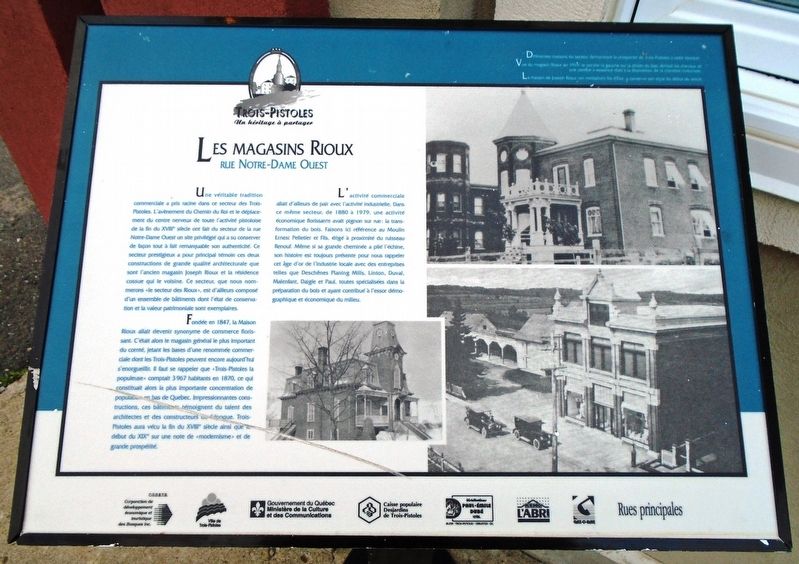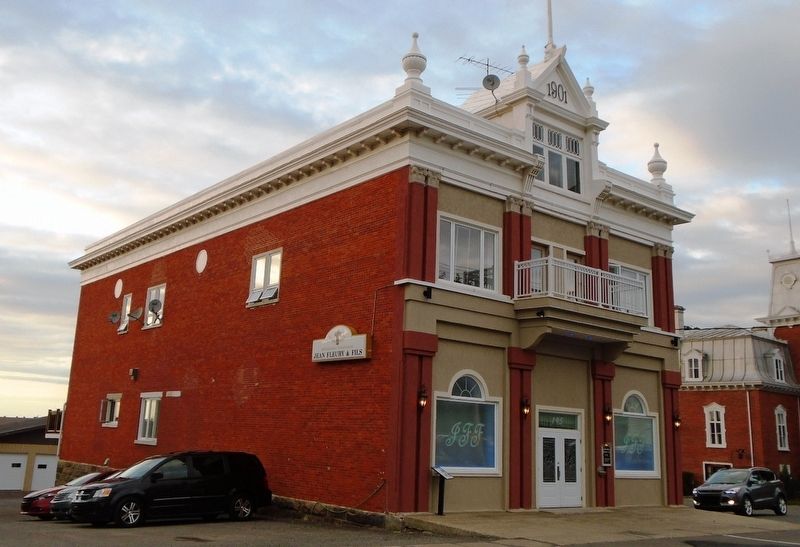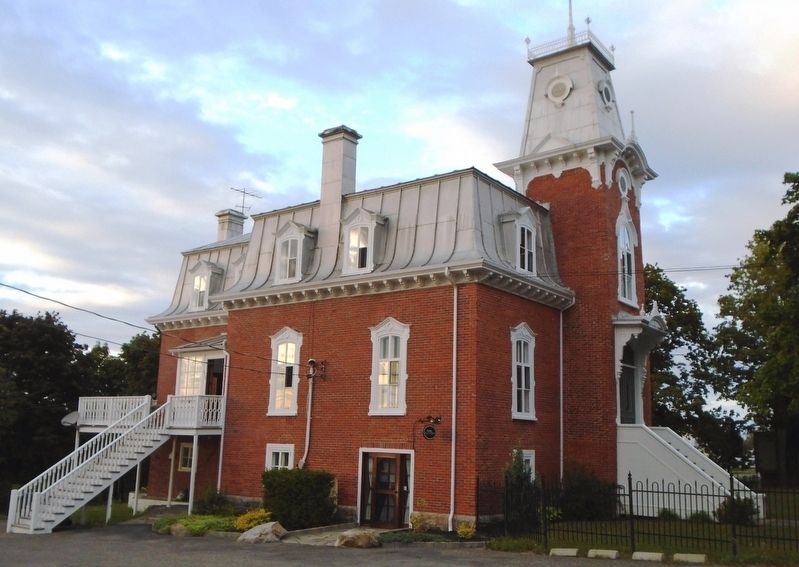Les magasins Rioux / The Rioux Shops
rue Notre-Dame Ouest
Une véritable tradition commerciale a pris racine dans ce secteur des Trois-Pistoles. L'avènement du Chemin du Roi et le déplacement du centre nerveux de toute l'activité pistoloise de la fin du XVIIIe siècle ont fait du secteur de la rue Notre-Dame Ouest un site privilégié qui a su conserver de façon tout à fait remarquable son authenticité. Ce secteur prestigieux a pour principal témoin ces deux constructions de grande qualité architecturale que sont l'ancien magasin Joseph Rioux et la résidence cossue qui le voisine. Ce secteur, que nous nommerons « le secteur des Rioux », est d'ailleurs composé d'un ensemble de bâtiments dont l'état de conservation et la valeur patrimonale sont exemplaires.
Fondée en 1847, la Maison Rioux allait devenir synonyme de commerce florissant. C'était alors le magasin général le plus important du comté, jetant les bases d'une renommée commerciale dont les Trois-Pistoles peuvent encore aujourd'hui s'enorgueillir. Il faut se rappeler que « Trois-Pistoles la populeuse » comptait 3 967 habitants en 1870, ce qui constituait alors la plus importante concentration de populations
en base de Québec. Impressionnantes constructions, ces bâtiments témoignent du talent des architectes et des constructeurs de l'époque. Trois-Pistoles aura vécu la fin du XVIIIe siècle ainsi que le début du XIXe sur une note de « modernisme » et de grande prospérité.L'activité commerciale allait d'allieurs de pair avec l'activité industrielle. Dans ce même secteur, de 1880 à 1979, une activité économique florissante avait pignon sur rue : la transformation du bois. Faisons ici référence au Moulin Ernest Pelletier et Fils, érigé à proximité du ruisseau Renouf. Même si sa grande cheminée a plié l'échine, son histoire est toujours présente pour nous rappeler cet âge d'or de l'industrie locale avec des entreprises telles que Deschênes Planing Mills, Linton, Duval, Malenfant, Daigle et Paul, toutes spécialisées dans la préparation du bois et ayant contribué à l'essor démographique et économique du milieu.
[Les légendes des photos lues]
• Différentes maisons du secteur demontrent la prospérité de Trois-Pistoles à cette époque.
• Vue du magasin Rioux en 1919, le porche (à gauche sur la photo du bas) abritait les chevaux et une pompe à esssence [sic] était à la dispostion de la clientèle motorisée.
• La maison de Joseph Rioux (en médaillon) fils d'Éloi, a conservé son style du début du siècle.
A real commercial tradition has taken root in this part of Trois-Pistoles. The advent of the King's Highway and the displacement of the center of all the area's economic activity at the end of the 18th century made the Notre Dame Street West neighborhood a privileged place which has preserved its authenticity in a very remarkable way. This prestigious sector has for principal witness these two buildings of high architectural quality; the old Joseph Rioux store and its neighboring opulent residence. This area, called "the Rioux sector," is also composed of a group of buildings whose state of conservation and heritage value are exemplary.
Founded in 1847, the Rioux Store became synonymous with flourishing commerce. It was then the county's largest general store, laying the foundation for a commercial renown that Trois-Pistoles can still boast today. It must be remembered that the "Trois-Pistoles sector" had 3,967 inhabitants in 1870, which was then the largest concentration of populations in Quebec. Impressive buildings, these buildings reflect the talent of contemporary architects and builders. Trois-Pistoles in the late eighteenth and early nineteenth centuries was noted for "modernism" and great prosperity.
Commercial activity went hand in hand with industrial activity. In the same sector, from 1880 to 1979, a thriving economy was well established:
[Photo captions read]
• View of the Rioux Shop in 1919: the bays (on the left in the picture below) housed the horses, and a petrol pump was at the disposal of motorized customers.
• The Joseph Rioux House (inset) son of Eloi, has retained its early 20th century style. [needs better translation]
• Local area houses show the prosperity of Trois-Pistoles at that time.
Erected by Ville de Trois-Pistoles, C.O.D.E.T.B., Culture et des Communications Quebec, et al.
Topics. This historical marker is listed in these topic lists: Environment • Industry & Commerce • Settlements & Settlers. A significant historical year for this entry is 1847.
Location. 48° 7.392′ N, 69° 10.865′ W. Marker is in Trois-Pistoles, Québec, in Les Basques. Marker is at the intersection of rue Notre-Dame Ouest and rue de Vitré, on the right when traveling west on rue Notre-Dame
Other nearby markers. At least 6 other markers are within 18 kilometers of this marker, measured as the crow flies. L'Institutionnel Église - Couvent - Presbytère (approx. half a kilometer away); Le Cheval Noir / The Black Horse (approx. half a kilometer away); L'île-aux-Basques / Isle of the Basques (approx. half a kilometer away); 100e anniversaire de l'église Notre-Dame-des-Neiges (approx. half a kilometer away); Le couvent du Saint-Rosaire / The Saint-Rosaire Convent (approx. 16.7 kilometers away); L'Église / The Church (approx. 16.8 kilometers away).
Also see . . .
1. Ville de Trois-Pistoles. (Submitted on November 5, 2018, by William Fischer, Jr. of Scranton, Pennsylvania.)
2. Timber Trade History at The Canadian Encyclopedia. (Submitted on November 5, 2018, by William Fischer, Jr. of Scranton, Pennsylvania.)
Credits. This page was last revised on January 20, 2020. It was originally submitted on November 4, 2018, by William Fischer, Jr. of Scranton, Pennsylvania. This page has been viewed 150 times since then and 11 times this year. Photos: 1, 2, 3. submitted on November 5, 2018, by William Fischer, Jr. of Scranton, Pennsylvania.


